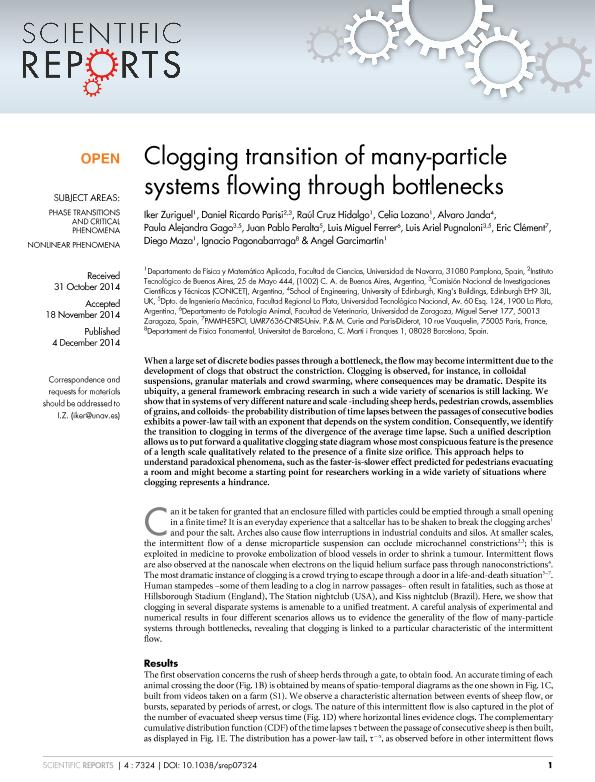Artículo
Clogging transition of many-particle systems flowing through bottlenecks
Zuriguel, Iker; Parisi, Daniel Ricardo ; Hidalgo, Raúl Cruz; Lozano, Celia; Janda, Álvaro; Gago, Paula Alejandra
; Hidalgo, Raúl Cruz; Lozano, Celia; Janda, Álvaro; Gago, Paula Alejandra ; Peralta, Juan Pablo
; Peralta, Juan Pablo ; Ferrer, Luis Miguel; Pugnaloni, Luis Ariel
; Ferrer, Luis Miguel; Pugnaloni, Luis Ariel ; Clément, Eric; Maza, Diego; Pagonabarraga, Ignacio; Garcimartín, Angel
; Clément, Eric; Maza, Diego; Pagonabarraga, Ignacio; Garcimartín, Angel
 ; Hidalgo, Raúl Cruz; Lozano, Celia; Janda, Álvaro; Gago, Paula Alejandra
; Hidalgo, Raúl Cruz; Lozano, Celia; Janda, Álvaro; Gago, Paula Alejandra ; Peralta, Juan Pablo
; Peralta, Juan Pablo ; Ferrer, Luis Miguel; Pugnaloni, Luis Ariel
; Ferrer, Luis Miguel; Pugnaloni, Luis Ariel ; Clément, Eric; Maza, Diego; Pagonabarraga, Ignacio; Garcimartín, Angel
; Clément, Eric; Maza, Diego; Pagonabarraga, Ignacio; Garcimartín, Angel
Fecha de publicación:
11/2014
Editorial:
Nature Publishing Group
Revista:
Scientific Reports
e-ISSN:
2045-2322
Idioma:
Inglés
Tipo de recurso:
Artículo publicado
Clasificación temática:
Resumen
When a large set of discrete bodies passes through a bottleneck, the flow may become intermittent due to the development of clogs that obstruct the constriction. Clogging is observed, for instance, in colloidal suspensions, granular materials and crowd swarming, where consequences may be dramatic. Despite its ubiquity, a general framework embracing research in such a wide variety of scenarios is still lacking. We show that in systems of very different nature and scale -including sheep herds, pedestrian crowds, assemblies of grains, and colloids- the probability distribution of time lapses between the passages of consecutive bodies exhibits a power-law tail with an exponent that depends on the system condition. Consequently, we identify the transition to clogging in terms of the divergence of the average time lapse. Such a unified description allows us to put forward a qualitative clogging state diagram whose most conspicuous feature is the presence of a length scale qualitatively related to the presence of a finite size orifice. This approach helps to understand paradoxical phenomena, such as the faster-is-slower effect predicted for pedestrians evacuating a room and might become a starting point for researchers working in a wide variety of situations where clogging represents a hindrance.
Palabras clave:
FLOW
,
BOTTLENECKS
,
CLOGGING
Archivos asociados
Licencia
Identificadores
Colecciones
Articulos(CCT - LA PLATA)
Articulos de CTRO.CIENTIFICO TECNOL.CONICET - LA PLATA
Articulos de CTRO.CIENTIFICO TECNOL.CONICET - LA PLATA
Articulos(SEDE CENTRAL)
Articulos de SEDE CENTRAL
Articulos de SEDE CENTRAL
Citación
Zuriguel, Iker; Parisi, Daniel Ricardo; Hidalgo, Raúl Cruz; Lozano, Celia; Janda, Álvaro; et al.; Clogging transition of many-particle systems flowing through bottlenecks; Nature Publishing Group; Scientific Reports; 4; 11-2014; 7324-7324
Compartir
Altmétricas



